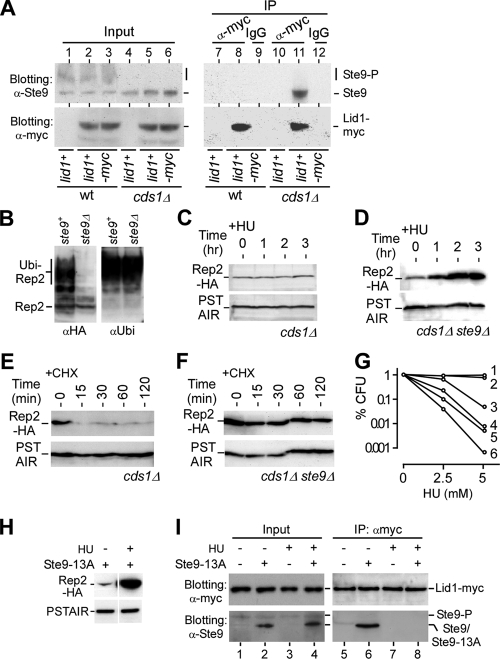FIG. 7.
Cds1-dependent phosphorylation of Ste9 inhibits Ste9 interaction with APC/C at the onset of S-phase arrest. (A) Cds1-dependent phosphorylation of Ste9 is required to block Ste9 interaction with APC/C at the S-phase arrest. Coimmunoprecipitation (IP) using anti-myc antibodies shows that Ste9 is associated with Lid1-myc in HU-treated cds1Δ (lane 11) but not wild-type (wt) (lane 8) cells. IgG antibodies were used as a negative control (lanes 9 and 12). (B) Disruption of ste9 prevents Rep2 from being ubiquitinated. The in vivo ubiquitin assay shows that the ubiquitinated Rep2 is hardly detected in ste9Δ cells, in contrast to the case for wild-type cells. (C) Rep2 accumulation is diminished in cds1 cells. Western blot analysis shows the level of Rep2 in cds1Δ cells after HU treatment. (D) Disruption of ste9 restores the stability of Rep2 in cds1Δ cells upon HU treatment. Western blot analysis shows the level of Rep2 in cds1Δ ste9Δ cells at various time points after HU treatment. (E) Turnover of Rep2 in S-phase checkpoint-deficient cds1Δ cells. Western blot analysis shows that the level of Rep2 decreases soon after addition of CHX. (F) Disruption of ste9 restores the Rep2 stability in cds1Δ cells. Western blot analysis shows that the rate of turnover of Rep2 is reduced in cds1Δ ste9Δ cells. (G) Disruption of ste9 alleviates the HU-sensitive phenotype of rad3Δ or cds1Δ cells. The duration of the HU treatment is approximately a generation time (∼3 h). Numbers indicate the strains: 1, wild type; 2, ste9Δ; 3, cds1Δ ste9Δ; 4, cds1Δ; 5, rad3Δ ste9Δ; and 6, rad3Δ. (H) Rep2 is accumulated in cells bearing the ste9-13A allele upon S-phase arrest. Western blot analysis shows the Rep2 level in cells bearing the ste9-13A allele treated or untreated with HU. (I) Ste9-13A fails to interact with Lid1 upon HU treatment. The input level of Lid1 or Ste9/Ste9-13A in samples used in coimmunoprecipitation assay is shown in lanes 1 to 4. Proteins that are enriched with Lid1-myc by the anti-myc antibodies are shown in lanes 5 to 8. Interaction between Lid1 and Ste9-13A is apparent (lane 6) in asynchronous cells (untreated with HU). On the other hand, the interaction between Ste9-13A and Lid1 is diminished in cells treated with HU (lane 8).

